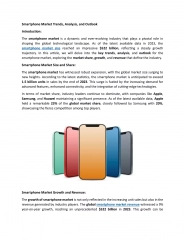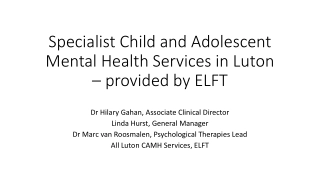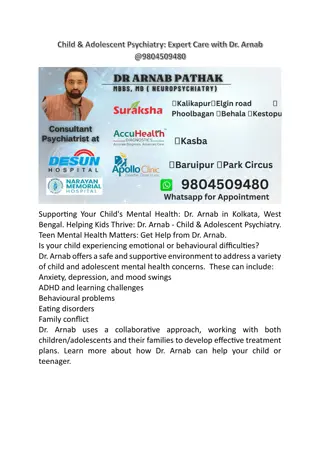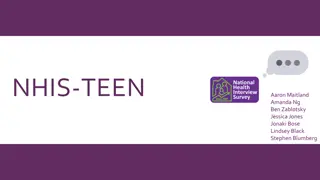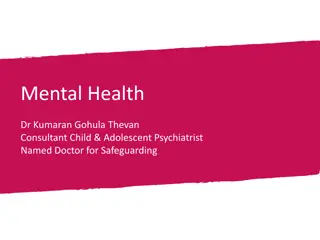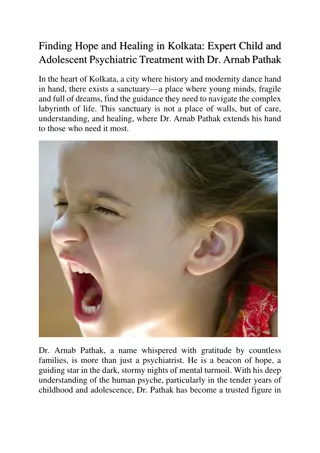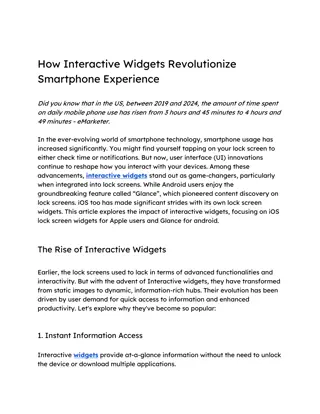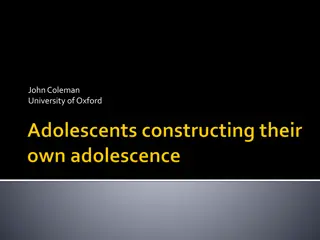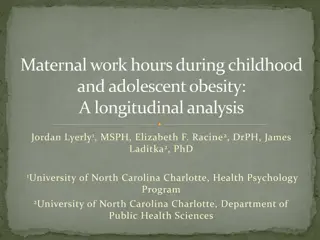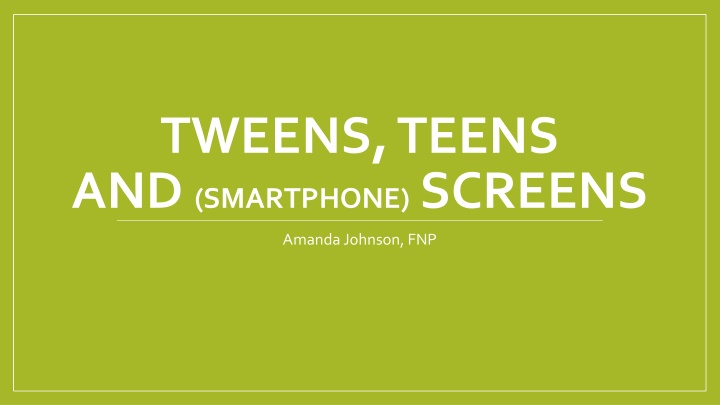
Concerns About Adolescent Mental Health Due to Smartphone Usage
There has been a concerning increase in mental health issues among adolescents, attributed to excessive smartphone usage. Statistics reveal rising rates of depression, self-harm, and suicide among teens, linked to the proliferation of smartphones and constant internet access. Research points to a correlation between social media use and heightened anxiety and depression symptoms, prompting calls for warnings about its impact on youth mental health.
Download Presentation

Please find below an Image/Link to download the presentation.
The content on the website is provided AS IS for your information and personal use only. It may not be sold, licensed, or shared on other websites without obtaining consent from the author. If you encounter any issues during the download, it is possible that the publisher has removed the file from their server.
You are allowed to download the files provided on this website for personal or commercial use, subject to the condition that they are used lawfully. All files are the property of their respective owners.
The content on the website is provided AS IS for your information and personal use only. It may not be sold, licensed, or shared on other websites without obtaining consent from the author.
E N D
Presentation Transcript
TWEENS, TEENS AND (SMARTPHONE)SCREENS Amanda Johnson, FNP
Why are we concerned? Dramatic increase in rates of mental health problems in adolescents in the past two decades Major depression among teenagers (12-17yo) in the US have increased: 145% for girls since 2010 161% for boys since 2010 ER visits for self-harm have among children 10-14 increased: 188% for girls since 2010 48% for boys since 2010 Suicide is the second leading cause of death for children 10-14: 167% increase for girls since 2010 91% increase for boys since 2010
What is causing this change? Trend is not unique to the United States; similar patterns are being seen in Canada, the UK, Australia, New Zealand, and many other developed nations Cell phones are not the problem communication is the not the issue, but smartphones and 24/7 access to the internet and endless apps are dangerous to developing minds First iPhone came out in 2007, the App Store was introduced in 2008, and the iPad came out in 2010 2011: 23% of teenagers had a smart phone 2015: 73% of teenagers had a smart phone In 2015, a quarter of teenagers said they were online almost constantly
Childhood is Causing an Epidemic of Mental Illness. Penguin Press, 2024. Haidt, Jonathan. The Anxious Generation: How the Great Rewiring of
Childhood is Causing an Epidemic of Mental Illness. Penguin Press, 2024. Haidt, Jonathan. The Anxious Generation: How the Great Rewiring of
Childhood is Causing an Epidemic of Mental Illness. Penguin Press, 2024. Haidt, Jonathan. The Anxious Generation: How the Great Rewiring of
Surgeon Generals Warning about Impact of Social Media on Youth Mental Health In June of this year, the Surgeon General called for social media platforms to have a warning label advising parents that using the platforms may damage adolescent mental health Adolescents who spend more than three hours a day on social media have double the risk of anxiety and depression symptoms Average daily use of social media for adolescents was 4.8 hours (as of summer 2023) Nearly half of adolescents say social media makes them feel worse about their bodies
How can smartphones be so damaging? 1. Opportunity cost: 24 hours in a day. American teens spend about 5 hrs a day on social media alone. What activities can they no longer do with that lost time? Experience boredom? 2. Social deprivation interacting with people in the virtual world, or even people you know IRL, via text, does not nourish growth and development and relationship formation in the same way that interacting with each other synchronously and in person does. 3. With more time on devices, most kids are getting LESS SLEEP. 4. Attention fragmentation phones supplant the need to maintain attention for any lengthy period of time. 5. Behavioral addiction addictive behavior is addictive behavior regardless of the substance.
So what do we do about it? Collective problems can be solved with collective action we must change cultural and societal norms! Adopting four basic principles can dramatically reduce or reverse these trends: No smartphone until high school 1. 2. No social media until 16+ Phone-free schools all day, truly phone-free, not just phone-free classrooms Some schools have tried phone pouches like Yonder; Virginia has adopted a state-wide policy banning cell phones for grades K-12 that goes into effect January 1st The less we rely on teachers to monitor or police device use, the more time they have to actually teach our (less distracted) kids! 3. 4. More independence, responsibility, and free play in real life! We are overprotecting our kids in the real world and failing to protect them online!
What if Ive already gotten my kiddo a phone? You can always take it back this is not a binding contract! Consider an alternative device smart watch? Dumb phone? Set up your child s phone for a minor with parental controls. Involve your kid in creating a contract about safe device use. Tell your child that their phone will have a passcode that you know, and that you will be checking it regularly. Create guidelines about phone use for you child and in your home. No phones at the dinner table Device curfew no phones in bedroom at night No phones when friends are over ALL devices (including friends ) can stay in a box Turn off notifications! Let your kid know you will be there to help them resolve problems when they (inevitably) screw it up! There is a plethora resources to help parents navigate what is undeniably fraught and tricky area
Helpful Resources and Further Reading Podcasts: Highly recommend this podcast where Dr. Becky interviews Jonathan Haidt right after his book came out, as well as this podcast, a recording of a moderated conversation between Dr. Becky and Haidt. This podcast, an interview with a psychiatrist on the Screen Strong podcast, is also full of great information. Screen Strong: A nonprofit that helps parents navigate healthy screen use and resolve problematic behavior, especially around social media, pornography, and video games. They have an online community, Facebook group, podcast, and courses for parents and kids about safe media use. The Anxious Generation: Website of social scientist, NYU professor, and NYT bestselling author Jonathan Haidt. The website has a huge resource library, with book recommendations, resources for families and educators, newsletters, videos, podcasts, and recommendations for alternatives to smartphones! There is also a pdf he created with Dr. Becky and Good Inside to help parents navigate this territory. Good Inside: Website of Dr. Becky, clinical psychologist and parenting expert; has lots of online parenting classes, including one on managing screen time. Social Media and Youth Mental Health: The US Surgeon General s Advisory provides lots of information and data guiding the recommendation to put warning labels on social media. Healthy Children: Consumer-facing website of the American Academy of Pediatrics, with lots of resources to help families navigate media use. Wait Until Eighth: Collective agreement parents can sign agreeing to wait until *at least* the summer after 8th grade to get their kid a smartphone. (The pledge becomes active for a school once the parents of at least ten students in the same grade and school have signed it; it is active at Tilden MS, so you can tell your child they re not the only one without a smartphone at Tilden!) Parent Encouragement Program: Kensington-based nonprofit that offers in-person and virtual parenting classes and lectures to help parents and caregivers build strong and harmonious family relationships. They have a few online course look here for one about social media (free!), and here and here for talks about setting boundaries around tech ($25 each).
Sources Barry Ellen, Kang Cecilia. Surgeon General Calls for Warning Labels on Social Media Platforms. The New York Times. June 17, 2024. Haidt, Jonathan. End the Phone Based Childhood Now. The Atlantic. March 13, 2024. Haidt, Jonathan. The Anxious Generation: How the Great Rewiring of Childhood is Causing an Epidemic of Mental Illness. Penguin Press, 2024. Hempe, Melanie. A Psychiatrist s Perspective on Screen Addiction with Dr. Adriana Stacey. ScreenStrong Families. January 25, 2023. https://podcasts.apple.com/us/podcast/screenstrong-families/id1474681355. Accessed November 8, 2024. Kennedy, Becky. The Anxious Generation with Jonathan Haidt. Good Inside with Dr. Becky. March 26, 2024. https://www.goodinside.com/podcast/7065/the-anxious-generation-with-jonathan-haidt/. Accessed November 8, 2024. Kennedy, Becky. The Anxious Generation: Dr. Becky & Jonathan Haidt in Conversation with Stephanie Ruhle at 92NY. Good Inside with Dr. Becky. October 22, 2024. https://www.goodinside.com/podcast/9394/the-anxious-generation-dr- becky-jonathan-haidt-in-conversation-with-stephanie-ruhle-at-92ny/. Accessed November 8, 2024. Murthy, Vivek H. Surgeon General: Why I m Calling for a Warning Label on Social Media Platforms. The New York Times. June 17, 2024.

